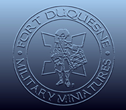

Name: “Grenadier Guards, circa 1980”
“Coldstream Guards, circa 1980”
Sculptor: David Grieve
Price:
Scale: 65mm
This review was Sent to me by Ned Ricks To whom I must apologise for taking so long to publish it.
The Grenadier Guards are
the senior regiment among the Foot Guards of the British Army, and, therefore,
always stand in the position of honor when on parade - on the right flank.
As a mark of their seniority, the regiment wears their tunic buttons in
singles (representing the First Regiment of Foot Guards), while the other
regiments wear their buttons in groupings denoting their seniority (e.g.
the Coldstreams wear pairs, The Scots Guards wear threes, The Irish Guards
wear fours and the relatively new Welsh Guards wear fives.) The bearskin
hat is worn in honor of the First Regiment of Foot Guards’ defeat of Napoleon’s
Guard Imperiale at the climax of the Battle of Waterloo in 1815.
The French Guard had been the most famous regiments to wear the imposing
headgear to that date, but the British have made it world famous even today.
After the 1830’s all the British regiments of Foot Guards wore the distinctive
hat. The white plume worn on the left side of the Grenadier’s bearskin shows
that this regiment stands on the right, and so all friendly forces must
be on their left. The Coldstream Guards were actually established before
the Grenadiers, but were not made part of the Royal Guards until later.
Because of this happenstance, they are second in seniority according to
everyone but themselves. Therefore, they stand on the far left of the line,
regardless of which regiments are present and so their plume is on the right
of their bearskin. Their regimental motto is that they are “Second to None.”
David F. Grieve was the sculptor of
these figures as he did all my favorites in this the series of guardsmen.
Fort Duquesne Military Miniatures has cast the figures in butter colored
polyurethane resin. The Grenadier’s body, rifle and base are the only three
parts, and all parts are extremely crisp and well done with no flash or
excess whatever.
The Coldstreamer’s arms are cast separate from the body with one hand grasping
the self-loading rifle (SLR). The painting instructions are general for
all the figures of the various regiments and match with the excellent photo
provided as box art. However, as I mentioned before, the details of the
rear skirts of the tunic, not seen in the photo, could be better described.
I needed to check with some picture books in the library. I recommend The
Guards by John de St. Jorre. Both the figures were cast as Guardsmen (in
other regiments called “Privates”), and I have converted them to Non-Commissioned
Officers as seen in the accompanying pictures.
The Grenadier’s rifle is cast with bayonet affixed, but I removed it and
placed the it in the hip sheath as guards sergeants do not carry rifles
with bayonets on them. The stripes on the corporal are my addition and are
cut from paper and attached with white glue. The sergeant wears a crest
on his right sleeve and a sash from right shoulder to left hip as a further
badge of rank. This was fabricated from some appropriate metal foil. British
Foot Guards are one of my favorite subjects and even a first time figures
modeler could not go far wrong with either of these figures which are sold
separately.
My source was Fort Duquesne Military Miniatures 105 Tristan Drive, Pittsburgh
PA 15209.
Their e-mail address
is ftduq@usaor.net.
Ned B. Ricks IPMS #36013